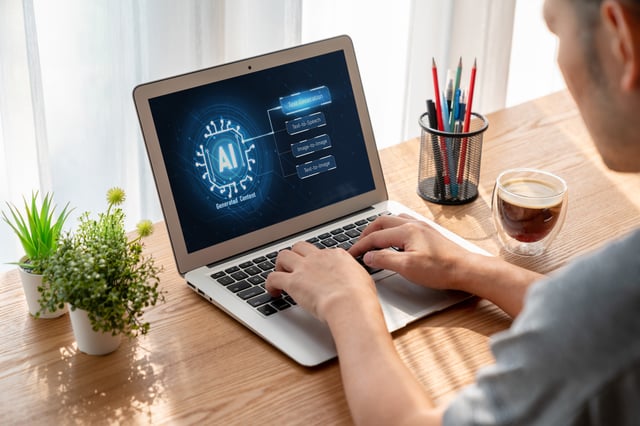The AI Marketing Revolution: Transforming Strategies and Skyrocketing Results

The AI marketing world is in a constant state of flux, but the current wave of change, driven by Artificial Intelligence (AI), is more than just a passing trend – it’s a fundamental revolution. AI Marketing is no longer a futuristic concept whispered about in high-tech circles; it’s a present-day reality, actively reshaping how businesses connect with their audiences, optimize their campaigns, and drive unprecedented growth. For marketers, understanding and harnessing the power of AI is rapidly becoming non-negotiable. But what does AI Marketing truly entail, and how can you navigate this complex yet incredibly promising landscape?
This post will serve as your comprehensive guide. We’ll delve into the essentials of AI Marketing, explore its transformative benefits, unpack core strategies, discuss the ever-expanding toolkit, and highlight how educational platforms like gibLink.ai are empowering marketers to not just survive, but thrive in this new era.
Section 1: What is AI Marketing? Decoding the Buzz
At its core, AI Marketing refers to the leveraging of artificial intelligence technologies to make automated decisions based on data collection and analysis, and to observe audience or economic trends that can impact marketing efforts. It’s about using AI to gain deeper insights, personalize experiences at scale, automate repetitive tasks, and ultimately, make marketing more efficient, effective, and impactful.
AI’s influence spans across numerous facets of marketing:
- Personalization: AI algorithms can analyze vast amounts of customer data (demographics, Browse history, purchase behavior, social media activity) to deliver highly personalized messages, product recommendations, and content, making each customer feel uniquely understood.
- Automation: From programmatic advertising and email campaign scheduling to social media posting and chatbot responses, AI can automate tasks that were previously time-consuming and resource-intensive, freeing up marketers to focus on strategy and creativity.
- Data Analysis & Predictive Insights: AI excels at sifting through complex datasets to identify patterns, predict future customer behavior, forecast trends, and provide actionable insights that would be impossible for humans to derive manually. This allows for more informed decision-making and proactive marketing strategies.
- Content Creation & Optimization: AI tools are increasingly capable of assisting with, and even generating, marketing copy, headlines, social media updates, and even basic visual content. Beyond creation, AI can also optimize existing content for better performance based on engagement data and SEO best practices.
- Customer Service: AI-powered chatbots and virtual assistants can provide 24/7 customer support, answer frequently asked questions, guide users through processes, and even handle simple transactions, enhancing customer satisfaction and reducing support costs.
In today’s hyper-competitive and data-rich environment, clinging to traditional marketing methods alone means falling behind. AI Marketing offers the tools and intelligence to connect with modern consumers in the way they expect: with relevance, immediacy, and value. It’s about working smarter, not just harder.
Section 2: The Transformative Benefits of AI in Marketing
Adopting AI in your marketing strategy isn’t just about keeping up with technological advancements; it’s about unlocking a suite of powerful benefits that can fundamentally transform your results.
- Enhanced Personalization at Scale: Generic marketing messages are increasingly ignored. AI allows for hyper-personalization, tailoring content, offers, and experiences to individual user preferences and behaviors. Imagine an e-commerce site where product recommendations dynamically change for every visitor based on their real-time interactions, or email campaigns where the subject line and content are uniquely crafted for each recipient. This level of personalization, delivered at scale, fosters deeper customer engagement and loyalty.
- Increased Efficiency through Automation: Marketing teams often find themselves bogged down by repetitive, manual tasks. AI-powered automation can take over many of these, such as data entry, report generation, A/B testing execution, lead scoring, and social media scheduling. This frees up valuable human resources to concentrate on higher-level strategic thinking, creative development, and building customer relationships. The result is a more agile and productive marketing operation.
- Deeper Customer Insights from Data Analytics: Data is the lifeblood of modern marketing, but its sheer volume can be overwhelming. AI algorithms are designed to process and analyze massive datasets far more quickly and accurately than humans can. They can uncover hidden patterns, identify micro-segments within your audience, understand customer journey pain points, and predict which leads are most likely to convert. These insights lead to more targeted campaigns, optimized resource allocation, and ultimately, a better understanding of your customers.
- Improved ROI and Campaign Optimization: AI can significantly enhance the return on investment (ROI) of your marketing spend. By continuously analyzing campaign performance in real-time, AI can identify what’s working and what’s not, automatically adjusting bids in programmatic advertising, optimizing ad creatives, or reallocating budget to higher-performing channels. This data-driven optimization ensures that marketing dollars are spent more effectively, minimizing waste and maximizing impact.
- Better Customer Experience (CX): From providing instant answers via chatbots to delivering highly relevant content and offers, AI contributes to a smoother, more responsive, and more satisfying customer experience. When customers feel understood and their needs are anticipated and met efficiently, their perception of the brand improves, leading to increased loyalty and advocacy.
- Enhanced Lead Generation and Nurturing: AI tools can analyze website visitor behavior to identify high-potential leads, personalize follow-up communications, and nurture them through the sales funnel with relevant information at the right time. This targeted approach increases conversion rates and shortens sales cycles.
The integration of AI into marketing is not just about incremental improvements; it’s about creating a more intelligent, responsive, and results-oriented marketing function that can adapt to the ever-changing demands of the digital landscape.
Section 3: Core AI Marketing Strategies to Implement
Understanding the “what” and “why” of AI Marketing is crucial, but the real power comes from implementing effective strategies. Here are some core ways AI is being strategically applied in marketing today:
- AI-Powered Content Creation and Curation:
- Strategy: Leveraging AI tools to assist in generating various forms of content, from blog post outlines and social media captions to email subject lines and product descriptions. AI can also help in curating relevant content from across the web to share with your audience.
- Application: Using Natural Language Generation (NLG) platforms (like Jasper, Copy.ai, or Writesonic) to overcome writer’s block, produce multiple variations of copy for A/B testing, or even draft initial versions of longer-form content. AI can also analyze top-performing content in your niche to suggest topics and formats that resonate with your target audience. For visual content, AI image and video generators (e.g., Midjourney, DALL-E 2, Synthesia) are emerging as powerful assistants.
- Predictive Analytics for Customer Behavior:
- Strategy: Utilizing AI and machine learning models to analyze historical and real-time data to forecast future customer actions, such as churn probability, likelihood to purchase, or lifetime value.
- Application: Identifying at-risk customers and proactively engaging them with retention offers. Segmenting audiences for targeted campaigns based on their predicted interest in a specific product or service. Optimizing pricing strategies based on demand forecasts.
- AI in SEO and SEM (Search Engine Optimization & Marketing):
- Strategy: Employing AI tools to conduct advanced keyword research, analyze competitor strategies, optimize content for search engines, automate bidding in PPC campaigns, and identify technical SEO issues.
- Application: Using platforms like Surfer SEO, MarketMuse, or Semrush (which often incorporate AI) to get recommendations for content structure, keyword density, and internal linking to improve organic rankings. For SEM, AI algorithms can manage bids in real-time across thousands of keywords to maximize conversions within a set budget (e.g., Google’s Smart Bidding).
- Chatbots and AI-Powered Customer Service:
- Strategy: Implementing AI-driven chatbots and virtual assistants to handle customer inquiries, provide instant support, qualify leads, and guide users through sales or support processes.
- Application: Deploying chatbots on websites and messaging apps to answer FAQs, troubleshoot common issues, collect customer information, and schedule appointments. More advanced AI can understand natural language, discern intent, and even detect sentiment, escalating complex issues to human agents when necessary.
- AI for Email Marketing Optimization:
- Strategy: Using AI to personalize email content, subject lines, and send times for individual subscribers, as well as to segment lists dynamically and automate email sequences.
- Application: AI tools can analyze past email engagement data to predict the optimal time to send an email to each subscriber for maximum open rates. They can also dynamically populate email content with personalized product recommendations or offers. AI can help write compelling subject lines and even A/B test them automatically.
- AI in Social Media Marketing:
- Strategy: Automating social media posting, analyzing social listening data to understand trends and sentiment, identifying influencers, and optimizing ad targeting on social platforms.
- Application: Using AI-powered social media management tools to schedule posts at optimal times, analyze the performance of different types of content, and gain insights into audience demographics and interests. AI can also help in identifying user-generated content and monitoring brand mentions.
Successfully implementing these strategies requires a clear understanding of your business goals, your target audience, and the capabilities of the available AI tools. It’s not about using AI for AI’s sake, but about strategically applying it to solve real marketing challenges and achieve specific objectives.
Section 4: Navigating the AI Marketing Toolkit: From Overwhelm to Opportunity
The AI Marketing landscape is booming, with new tools and platforms launching almost daily. This explosion of options is exciting, offering solutions for nearly every marketing challenge imaginable. However, it can also be incredibly overwhelming, leading to “shiny object syndrome,” decision paralysis, or investments in tools that don’t deliver the expected ROI.
Categories of AI Marketing Tools:
The AI marketing toolkit is vast and can be broadly categorized:
- Analytics and Data Insights: Tools that use AI to analyze customer data, track campaign performance, identify trends, and provide predictive insights (e.g., Google Analytics with AI features, HubSpot’s reporting, specialized AI analytics platforms).
- Content Generation and Optimization: A rapidly growing category that includes AI writers for text-based content (Jasper, Copy.ai, Rytr), AI image generators (Midjourney, DALL-E 2, Stable Diffusion), AI video creation tools (Synthesia, Pictory), and SEO optimization tools that use AI to guide content creation (Surfer SEO, MarketMuse).
- SEO and SEM Tools: Platforms that leverage AI for keyword research, competitor analysis, site audits, content optimization, and automated bid management for paid search (e.g., Semrush, Ahrefs (with AI features), Google Ads’ AI-powered bidding).
- Advertising and Programmatic Buying: AI algorithms that automate ad buying, target specific audiences across multiple platforms, and optimize ad creatives in real-time (e.g., Criteo, AdRoll, social media ad platforms’ AI targeting).
- Chatbots and Customer Communication: AI-powered chatbot platforms for websites and messaging apps that handle customer inquiries, qualify leads, and provide support (e.g., Intercom, Drift, Tidio).
- Email Marketing Platforms with AI: Email marketing services that incorporate AI for subject line optimization, send time personalization, content recommendations, and predictive segmentation (e.g., Mailchimp’s AI features, ActiveCampaign).
- Social Media Management Tools with AI: Platforms that use AI for content scheduling, social listening, sentiment analysis, influencer identification, and performance analytics (e.g., Sprout Social, Hootsuite (with AI components)).
Choosing the Right Tools:
The key to successfully navigating the AI toolkit is not to adopt every tool that comes along, but to strategically select those that align with your specific marketing goals, address your most pressing challenges, and integrate well with your existing technology stack. Consider:
- Your Objectives: What do you want to achieve? (e.g., increase lead generation, improve customer retention, boost content engagement, enhance personalization).
- Your Challenges: Where are your biggest pain points or inefficiencies?
- Integration: Will the tool work seamlessly with your CRM, analytics platforms, or other marketing software?
- Ease of Use: How steep is the learning curve for your team?
- Scalability: Can the tool grow with your business needs?
- Cost vs. Benefit: Does the potential ROI justify the investment?
The Value of Curated Directories and Guidance:
This is where resources like gibLink.ai become invaluable. Instead of sifting through countless options alone, platforms that offer a curated directory of vetted AI software can save marketers significant time and effort. gibLink.ai, for instance, provides a toolkit that specifically focuses on AI marketing, covering crucial categories. Such curated resources often come with insights, reviews, and guidance, helping marketers make more informed decisions. They act as a filter, highlighting tools that are proven and effective for specific marketing tasks.
For example, when looking for AI-powered SEO analysis, a curated directory might point you towards established tools like Semrush or MarketMuse, explaining their AI-driven features. For efficient content creation, it might recommend platforms like Jasper or Copy.AI, detailing their capabilities in generating various types of marketing copy. For visual generation, it could highlight tools like DALL-E 2 for images. This expert curation helps demystify the tool landscape and accelerates the adoption of effective AI solutions.
Ultimately, the goal is to build a complementary suite of AI tools that empowers your team, automates intelligently, and provides the insights needed to drive superior marketing performance. Take a moment to view our list of tools that we’ve compiled here.







Responses